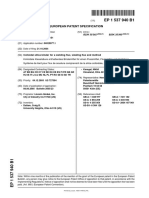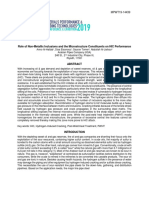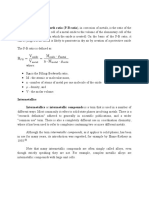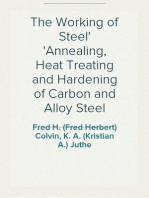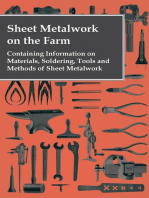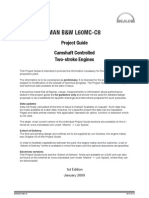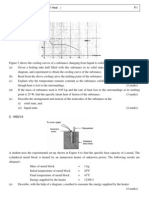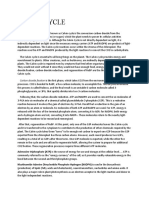0 ratings0% found this document useful (0 votes)
3 viewsUS4512822
US4512822
Uploaded by
rndCopyright:
© All Rights Reserved
Available Formats
Download as PDF, TXT or read online from Scribd
US4512822
US4512822
Uploaded by
rnd0 ratings0% found this document useful (0 votes)
3 views5 pagesCopyright
© © All Rights Reserved
Available Formats
PDF, TXT or read online from Scribd
Share this document
Did you find this document useful?
Is this content inappropriate?
Copyright:
© All Rights Reserved
Available Formats
Download as PDF, TXT or read online from Scribd
Download as pdf or txt
0 ratings0% found this document useful (0 votes)
3 views5 pagesUS4512822
US4512822
Uploaded by
rndCopyright:
© All Rights Reserved
Available Formats
Download as PDF, TXT or read online from Scribd
Download as pdf or txt
You are on page 1of 5
United States Patent (19) 11 Patent Number: 4,512,822
Barringer et al. (45) Date of Patent: Apr. 23, 1985
54) NON-HYGROSCOPICWELDING FLUX (57) ABSTRACT
BNDERS
A welding flux binder is provided which comprises an
75) Inventors: Eric A. Barringer, Waltham; Thomas alkali-alkaline earth silicate hydrolyzed and polymer
W. Eagar, Belmont, both of Mass. ized from tetraalkylorthosilicate, Si(OR)4, wherein R is
73) Assignee: Massachusetts Institute of -CH3, -C2H5, or -C3H7, and alkali and alkaline
Technology, Cambridge, Mass. earth salts. The reaction product of the tetraalkylor
thosilicate and metal salts, M2O.M"O.SiO2, where M is
21 Appl. No.: 626,613 potassium, sodium or lithium, and M' is magnesium,
22 Filed: Jun. 29, 1984 calcium or barium, has several advantages as a welding
51) Int. Cl. .............................................. B23K 35/34 flux binder. For example, it is not hygroscopic and can
52 U.S. C. ........................................ 148/24; 148/23; be prepared at low temperatures since the alkali ions
48/26 lower the melting point for viscous sintering of the gel
58) Field of Search ..................................... 148/23-26 phase. Because of the low temperature processing, a
wide variety of solid additives with low thermal stabil
56) References Cited ity, such as some metals, carbonates, and fluorides, can
U.S. PATENT DOCUMENTS be incorporated into the flux. Other dopants may also
3,985,586 10/1976 Choby ................................... 148/23 be readily incorporated into the binder during the gel
phase.
Primary Examiner-Peter D. Rosenberg
Attorney, Agent, or Firm-Arthur A. Smith, Jr.; Patrea
L. Pabst 6 Claims, No Drawings
4,512,822
1. 2
pound. CO2 aids in operability of the flux by increasing
NON-HYGROSCOPIC WELDING FLUX BNDERS the stability of the arc and by excluding atmospheric
BACKGROUND OF THE INVENTION
contamination, particularly N2, from the metal. Baking
at 1100° C. decomposes sources of CO2, such as calcium
Arc welding is by far the most common welding 5 carbonate, but does not allow diffusion of the calcium
process. The two main types of arc welding are sub into the sodium silicate to form an intimate mixture
merged arc welding (SAW) and shielded metal arc which is non-hygroscopic.
welding (SMAW). In submerged arc welding, coales Another problem with baking the fluxes at 1100° C.
cence is produced by heating with an electric arc be 10
to remove moisture is that metallic powders, which
tween a bare-metal electrode and the metal being may be added to provide alloying of the weld metal,
worked. The welding is blanketed with a granular or will oxidize during the baking operation. By lowering
fusible material or flux. The welding operation is started the necessary baking temperatures or by using less hy
by striking an arc beneath the flux to produce heat to groscopic weld fluxes that do not need frequent baking,
melt the surrounding flux so that it forms a subsurface 15
temperature sensitive alloy powders may be incorpo
conductive pool which is kept fluid by the continuous rated into the flux, thereby providing flexibility in the
flow of current. The end of the electrode and the work design of the fluxes.
piece directly below it become molten and molten filler Metal powders are added as required for alloying
metal is deposited from the electrode onto the work. with the various types of metals or steels to be welded.
The molten filler metal displaces the work and forms Fluorides may be added to lower the viscosity of the
the weld. In shielded metal arc welding, shielding is by 20 flux at operating temperature thereby altering the fluid
flux-coated electrodes or welding rods instead of a loose ity of the molten flux on the steel. Flexibility in choos
granular blanket of flux. ing the type of metal powders to be added to the flux
Fluxes are utilized in arc welding to control the arc rather than changing the composition of the steel rod
stability, modify the weld metal composition, and pro decreases the cost of the welding electrodes.
vide protection from atmospheric contamination. Arc 25 It is therefore an object of the present invention to
stability is controlled by modifying the composition of provide a welding flux composition which is not hygro
the flux. It is therefore desirable to have substances scopic.
which function well as plasma charge carriers in the It is another object of the present invention to pro
flux mixture. Fluxes also modify the weld metal compo vide a welding flux which can be produced and pro
sition by rendering impurities in the metal more easily 30
cessed at a temperature less than 1000 C. so that com
fusible and providing substances which these impurities pounds of low stability such as carbonate and alloying
may combine with in preference to the metal to form metal powders may be included.
slag. Practically all slag-forming compounds may be
classed as either acidic or basic, according to which It is yet a further object of the present invention to
compounds they react with. The substances which are 35 provide a flux which can be mixed with a number of
considered to be the most active "bases' are those different metal powders for alloying with different
which are compounds of the elements forming basic steels.
compounds in ordinary chemical reactions in water It is a still further object of the present invention to
solutions, such as calcium, magnesium, and sodium. The provide a binder for both shielded metal arc welding
most active "acid' impurities are compounds of silicon (SMAW) and submerged arc welding (SAW) fluxes.
and phosphorous. Silicon dioxide (SiO2) is the only It is another object of the present invention to pro
substance used as a strictly acid flux. Fluxes are pre vide a binder which yields a material with relatively
pared with a higher or lower percentage of acidic or high fired strength.
basic compounds, depending on the type of metal to be SUMMARY OF THE INVENTION
welded and impurities in the metal. In some instances, 45
other materials may be added to lower the slag melting The present invention is a welding flux binder com
point and to improve slag fluidity, and to serve as bind prising an alkali-alkaline earth silicate, M2O.M"O.SiO2,
ers for the flux particles. where M is lithium, sodium, or potassium or other ele
It follows that any improvement in welding fluxes or ment in Group I of the Periodic Table and M' is magne
flux binders is of benefit to the many industries which 50 sium, calcium or barium, or other element in Group II
utilize arc welding. of the Periodic Table, which is the reaction product of
A problem encountered in the welding industry is the hydrolyzed and polymerized tetraalkylorthosilicate,
absorption of moisture by the flux covering on welding Si(OR)4, wherein R is -CH3, -C2H5, or -C3H7, and
electrodes. Most welding electrode flux formulations metal compounds. This silicate binder which has a ho
consist of an oxide-based material (flux) and additives 55 mogeneous distribution of the alkali and alkaline earth
bonded together by sodium silicate (water glass). Dur ions, has several advantages. Tetraalkylorthosilicate
ing welding, the heat evaporates and dissociates the reacts chemically with water, and upon gelling, incor
water, evolving hydrogen gas, which dissolves into the porates the metal ions into the binder, thereby provid
metal. Under stress, the dissolved hydrogen may pro ing a homogeneous mixture of the binder components
duce cracks with the potential for catastrophic failure. unlike when sodium silicate particles are sintered. Due
In an effort to decrease the possibility of failure, the to the presence of the CaO or MgO, the fired binder is
presently available welding electrodes are baked at not hygroscopic. By including sources of K, Na+, or
1 100 C. to decrease the water in the flux to less than Litions to lower the melting point for viscous sintering
0.2%. These electrodes can then be used only for a of the gel phase, the binder can be prepared at tempera
limited time before the fluxes absorb moisture from the 65 tures as low as 400 C., so that compounds which are
air and have to again be baked out. unstable at higher temperatures, such as carbonate, may
A problem in addition to that of water absorption by be incorporated. The addition of carbonate is useful as a
these weld fluxes is their lack of a CO2 generating com CO2 generating compound. Dopants such as alloy or
4,512,822
3 4.
iron metal powders can also be included in the binder during the hydrolysis and polymerization of the tetrae
during the gel phase. thylorthosilicate.
DETAILED DESCRIPTION OF THE
The invention will be further understood from the
PREFERRED EMBODIMENT series of experiments, described in the following non
5 limiting examples, performed to determine the order of
The preferred embodiment of the present invention is addition of the various components of the flux, to opti
an alkali metal-alkaline earth-calcium silicate bound mize relative ratios of components of the flux, and to
weld flux formed of an oxide-based material, the reac compare the properties of the final fired products.
tion product of hydrolyzed and polymerized tetrae Two basic formulations were investigated using the
thylorthosilicate, Si(OC2H5)4, and metal compounds O same fundamental procedures. The first consisted of
such as carbonates and nitrates. The tetraethylortho Linde 80 TM (MnO-SiO2 glass) -200 mesh, CaCO3,
silicate is reacted by first dissolving the Si(OC2H5)4 in Si(OC2H5)4, ethanol, hydrochloric acid and water and
alcohol and adding acidified water to hydrolyze the was used in examples 1-4. The second formulation also
tetraethylorthosilicate. Sources of the alkali and alka contained K2CO3 and was used in example 5. All per
line earth metals are then dissolved in the solution. 15 cent is weight percent unless otherwise noted.
Metal carbonates, fluorides, flux, and other solids are
added to make a suspension of 10-50% solids. The sus EXAMPLE 1.
pension is neutralized and cast into a mold. The gelled Flux and CaCO3 were weighed and mixed. Si
product is fired at 400-1000 C. The typical slurry (OC2H5)4 was dissolved in ethanol and allowed to react
formulation is 50% solids with sufficient Si(OC2H5)4 to 20
for approximately 1 min. The solids, Si(OC2H5)4, and
generate 3-10 w/o silicate binder in the final fired prod water were mixed to produce a suspension containing
Ct.
Although tetraethylorthosilicate, Si(OC2H5)4 is used 50% solids and 5-10 w/o flux binder in the final prod
in the preferred embodiment, other tetraalkylorthosili uct. The mixture was cast in a mold, then fired at 750
C. for 6 hours.
cates may be used to provide a flux binder with similar 25
properties. For example, Si(OCH3)4 and Si(OC3H7)4 are EXAMPLE 2
acceptable substitutes for the tetraethylorthosilicate. Flux and CaCO3 were weighed and mixed. Si
There are a number of materials which may be used (OC2H5)4 was dissolved in ethanol. HCl was added
in the flux including manganese oxide (MnO), silicon dropwise to water and then mixed with the Si(OC2H5)4.
dioxide (SiO2), zirconium oxide (ZrO2), titanium oxide 30
in alcohol. The mixture was allowed to react for ap
(TiO2), fluorite (CaF2), alumina (Al2O3), magnesia proximately 1 min. The Si(OC2H5)4 solution was then
(MgO), iron oxide (Fe0), barium oxide (BaO), and mixed with the flux and CaCO3 to produce a suspension
calcia (CaO). A commercially available MnO-SiO2 flux
is Linde 80 TM, -200 mesh, manufactured by Union containing 50% solids and 5-10 w/o silicate. The mix
Carbide. 35 ture was cast in a mold, then fired at 750 C. for 6 hours.
During viscous sintering of the gel, the flux particles EXAMPLE 3
are fused together. Sintering behavior depends on the
chemistry of the gel phase (K+, Ca++) and on the Si(OC2H5)4 was dissolved in ethanol. HCl was drop
physical structure. The gel exists as small particles, wise added to water, then mixed with the Si(OC2H5)4-
approximately 100A of silicate “polymer' between the 40 alcohol solution and allowed to react for approximately
large flux grains and added compound grains. The gel, min. CaCO3 was then added to the alcohol solution to
which contains residual alcohol and water, serves as a neutralize the acid prior to adding the solid mixture of
"glue' between particles. Upon heating, the alcohol and flux and CaCO3. Two preparations were made, one
water are driven out of the gel and the particles fuse containing 5 w/o silicate and the other containing 7.5
together. In the present invention, temperatures of less 45 w/o silicate in the final product. The mixtures were cast
than 1000 C., and preferably between 500 C. and 800 in molds, then fired at 750 C. for 6 hours.
C., are adequate to sinter the flux. EXAMPLE 4
It is preferable to include in the flux binder an ele
ment from Group I of the Periodic Table, such as so The same procedure used in Example 3 was used in
dium, potassium or lithium. Na+, K+, and Li+ ions 50 Example 4. Si(OC2H5)4 was dissolved in ethanol. HCl
lower the melting point of the binder so that viscous was dropwise added to water, then mixed with the
sintering of the gel phase occurs at a relatively low Si(OC2H5)4-alcohol solution and allowed to react ap
temperature, between 400 C. to 750° C. Compounds proximately one minute. CaCO3 was added to the alco
Soluble in alcohol, such as nitrates, iodides, salicylates, hol solution to neutralize the acid prior to adding the
and carbonates, are the preferred sources of the alkali 55 solid mixture of flux and CaCO3. The Si(OC2H5)4 was
and alkaline earth ions. The role of the Ca+ + ions in the added to yield 8 w/o silicate in the final product. The
reaction product is to make the glass insoluble in water mixture was cast in a mold, then fired more than 24
and chemically resistant by “blocking" the structure hours at 750 C.
and suppressing diffusive processes. This same process EXAMPLE 5
makes consumer glass products such as bottles and 60
windows chemically stable. Si(OC2H5)4 was dissolved in ethanol. Acidified water
Other solids may be added to the flux material and was added to the Si(OC2H5)4 solution and allowed to
binder. For example, any powder which is insoluble in react for approximately 1 min. The water concentration
alcohol, such as reactive metals including iron, manga was then increased and CaCO3 and K2CO3 were added
nese, chromium, nickel, aluminum, titanium, vanadium, 65 to partially neutralize the acid. Flux, K2CO3, and
niobium, or boron or compounds thereof may be added CaCO3 were added to make a suspension containing a
to the flux formulation. Dopants, substances which concentration of 50% solids. The mixture was cast in a
dissolve in the solution, may be added to the gel phase mold, then fired at 800 C. for 3 hours.
4,512,822
5 6
The products of these experiments were compared by that potassium ions were necessary to lower the melting
a water test, green strength, and fired strength. The point for viscous sintering at the relatively low tempera
water test is a glycerine bubble test which simulates an ture of 500-750° C.
actual welding situation. A hole is drilled in the flux CaCO3 is not effective as a CO2 source since it is
sample and an arc is struck through this hole onto a soluble in the acidic solution. It is useful in partially
small piece of steel. The sample is quenched in water, neutralizing the acid solution, which is necessary for
the slag is removed and the steel is then placed in glyc gellation of the silicate binder.
erine. The presence or absence of a bubble stream of As shown in Example 5, acid neutralization causes
hydrogen is noted. Although somewhat simple, this test rapid conversion of the suspension to a gel (solid). Com
will usually react positively to properly dried elec O plete neutralization of the acid may result in rapid, un
trodes, indicating even small amounts of hydrogen. The controlled gellation of the solid suspension, however.
absence of bubbles means there is less than or equal to Since this would not be desirable in a welding rod man
0.1 w/o H2O. ufacturing process, the best way to control gellation
Green strength is a qualitative test. "No strength” would be to partially neutralize the acid, cast the weld
means the material is easy to crumble by hand. "Moder 15 ing flux by dipping the metal rod into the suspension,
ate strength" means the material can be broken into then expose the rod to an ammonia or base environment
small pieces with some difficulty. "High strength” (solution or gas) to complete the gellation. The advan
means that the material cannot be broken with reason tages of partial neutralization of the acid and gellation
able force. are that the suspension will remain stable for days with
Low fired strength means the sintered material is not 20 out undergoing "self-gellation', and that the gellation
too difficult to break. High fired strength means the process occurs in a very controlled fashion.
material cannot be broken by hand and is able to with In summary, a welding flux binder formed by sol-gel
stand impact. chemistry which produces a moisture resistant oxide by
It is desirable for the flux used on welding rods to be decomposition of the gel is disclosed.
able to withstand some impact in order to facilitate ease 25 The improved flux binder comprises an alkali-alkaline
of shipping and handling. earth silicate hydrolyzed and polymerized from tet
RESULTS raalkylorthosilicate, Si(OR4), wherein R is -CH3,
-C2H5, or -C3H7, and alkali and alkaline earth salts.
There was no polymerization or bonding in Example The general formula for the binder is M2O.M"O.SiO2,
1. 30 where M is preferably lithium, sodium, or potassium
In Example 2, there was low green strength and little and M' is preferably magnesium or calcium. When the
or almost no fired strength. There was no evidence of binder is used in a mixture with an oxide-based material,
hydrogen bubbles in the water test. preferably of small particle size, the product is a flux
Example 3 also showed low green strength and little that is not hygroscopic, that has a low melting point for
or almost no fired strength. No hydrogen bubbles were 35 viscous sintering, and which is flexible enough to allow
present in the water test. incorporation of carbonates, metal powders or other
In example 4, there was some green strength and low compounds with low thermal stability for improved
fired strength. Both the 5 w/o and 8 w/o silicate con flux properties and broader applicability in welding of
taining samples prepared from a suspension of 40% various metals.
solids and the 5 w/o silicate-containing sample prepared 40 The flux is prepared by acid hydrolysis and polymeri
from a suspension of 50% solids were castable. The zation of Si(OC2H5)4 dissolved in alcohol and partially
sample with 8 w/o silicate prepared from a suspension neutralized by the addition of a basic compound such as
of 50% solids was not castable. None of the samples calcium carbonate, to which Kit, Nat, or Li ions and
showed any evidence of hydrogen bubbles. other metal powders or compounds are added. The flux
The mixture in Example 5 rapidly formed hard green 45 is cast and fired attemperatures between 400 and 1000
pieces. The fired samples had considerable strength. C., preferably 500-750° C.
There was no evidence of hydrogen bubbles. The preferred embodiment of the binder is prepared
The following conclusions can be drawn from these from a suspension containing 40-60% solids consisting
results. of CaCO3, K2CO3 and other solids such as metals and
As shown by the examples, acid must be added to the 50 fluorides and 5-8 wo silicate in the final product. The
Si(OC2H5)4 alcohol solution to promote crosslinking preferred process is: dissolution of Si(OC2H5)4 in an
and gel formation. Although HCl was used in the exam alcohol such as ethanol, methanol, or propanol; dilution
ples, any strong acid may be used. Nitric acid is the of a strong acid such as nitric acid in water; mixing of
preferred acid since HCI may evolve chlorine which the Si(OC2H5)4-alcohol solution with the diluted acid;
can form phosgene gas during arc welding. H2SO4 is 55 addition of CaCO3, alkaline earth and alkali salts and
also not preferred since it may cause some trace sulfur other dopants and solids to the Si(OC2H5)4 solution to
contamination of the steel or metal being welded. form a suspension with 40-60% solids; neutralization of
The amount of water present in the samples prepared the acid to cause gel formation, and firing at 400
from a suspension containing 50% solids as in Examples C-1000° C., preferably 500-750 C.
1-4 is probably too low to allow adequate hydrolysis 60 Although this invention has been described with
and polymerization of the Si(OC2H5)4. The water level reference to specific embodiments, it is understood that
in Example 5 showed better results. The preferred modifications and variations may occur to those skilled
molar ratio of water to Si(OC2H5)4 is between 4 and 10, in the art. It is intended that all such modifications and
although a broader range is possible. variations be included within the scope of the appended
The relative insolubility in acidic alcohol of K2CO3, 65 claims.
the CO2 source in the flux, and the thermal stability it What is claimed is:
provides, allows greater flexibility of polymerization 1. A process for making a welding flux comprising:
kinetics and processing techniques. The results showed a dissolving tetraalkylorthosilicate in alcohol;
4,512,822
7 8
b. diluting a strong acid in water; 3. The process of claim 1 further comprising the step
c. reacting the tetraalkylorthosilicate and acid solu of dipping a welding rod into the suspension prior to the
tions; gel formation step (g).
d. adding at least one alkali compound; 4. The process of claim 3 wherein step (g) comprises
exposing the dipped welding rod to a basic environ
e. adding at least one alkaline earth compound; nent.
f. adjusting the solids content of the suspension of 5. The process of claim 1 wherein the alkaline earth
step (e) to 40-60% solids; compound of step (e) is selected from the group consist
g. neutralizing the acid to cause gel formation; and ing of the nitrate, iodide, salicylate, and carbonate of an
h. firing the 40-60% solids suspension at a tempera O element selected from the group consisting of calcium,
ture between 400 C. and 1000 C. for between six magnesium, and barium.
and 24 hours. 6. The process of claim 1 wherein the alkali com
pound of step (d) is selected from the group consisting
2. The process of claim 1 further comprising the step of the nitrate, iodide, salicylate, and carbonate of an
of casting the suspension in a mold prior to the gel 15 element in Group I of the Periodic Table.
formation step (g).
20
25
30
35
40
45
50
55
60
65
You might also like
- Anaconda ManualDocument20 pagesAnaconda Manualsergio3h33largo3cocu100% (1)
- Batik - Art and Craft (Art Ebook)Document76 pagesBatik - Art and Craft (Art Ebook)Muhiddin Chandra100% (1)
- Colloidal Silica Binder For A Welding Flux and Method PDFDocument26 pagesColloidal Silica Binder For A Welding Flux and Method PDFBurag HamparyanNo ratings yet
- Australian/New Zealand Standard: Classification of Hazardous Areas Part 3.1: Examples of Area Classification-GeneralDocument7 pagesAustralian/New Zealand Standard: Classification of Hazardous Areas Part 3.1: Examples of Area Classification-Generalmuneeb.irfan98730% (1)
- Mil PRF 61002aDocument30 pagesMil PRF 61002aAbdullah PalNo ratings yet
- FM-200 Manual PDFDocument33 pagesFM-200 Manual PDFMohammad Abdul Khadeer100% (3)
- The Efficacy of ProSeal™, SeLECT Defense™, OrthoCoat™, and Biscover LV™ Resin Sealants On The Prevention of Enamel Demineralization and White Spot Lesion FormationDocument64 pagesThe Efficacy of ProSeal™, SeLECT Defense™, OrthoCoat™, and Biscover LV™ Resin Sealants On The Prevention of Enamel Demineralization and White Spot Lesion FormationReliance Orthodontic Products100% (1)
- HicDocument18 pagesHicIlkin hasanovNo ratings yet
- Acid Pickling of Carbon SteelDocument10 pagesAcid Pickling of Carbon SteelAnoop KizhakathNo ratings yet
- Gas Metal React Wps Office 1Document13 pagesGas Metal React Wps Office 1Prafulla Subhash SarodeNo ratings yet
- Bhadeshia, H. - Prevention of Hydrogen Embrittlement in Steels PDFDocument35 pagesBhadeshia, H. - Prevention of Hydrogen Embrittlement in Steels PDFLuis Gustavo PachecoNo ratings yet
- Experimental Study On Primary Scale Formation and Descalability On Steels Containing Ni and Ni+SiDocument9 pagesExperimental Study On Primary Scale Formation and Descalability On Steels Containing Ni and Ni+SiMada TetoNo ratings yet
- US4662952Document6 pagesUS4662952rndNo ratings yet
- US3819406Document7 pagesUS3819406Vikin JainNo ratings yet
- Welding and Corrosion Performance of INCO-WELD 686CPT Filler Metal in Waste-To-Energy Power PlantsDocument6 pagesWelding and Corrosion Performance of INCO-WELD 686CPT Filler Metal in Waste-To-Energy Power PlantsErdem ÜnelNo ratings yet
- Chapter 11.-Electroslag Remelting of Copper and Its AlloysDocument2 pagesChapter 11.-Electroslag Remelting of Copper and Its AlloysJesús Francisco Vidaňa DuronNo ratings yet
- Bab 27B Pengelasan FusiDocument60 pagesBab 27B Pengelasan FusiAqil AthoillahNo ratings yet
- Kamal's Soldering &weldingDocument47 pagesKamal's Soldering &weldingRicha AhlawatNo ratings yet
- Role of Non Metallic Inclusions and The Microstructure Constituents On Hic PerformanceDocument14 pagesRole of Non Metallic Inclusions and The Microstructure Constituents On Hic PerformanceMubeenNo ratings yet
- Stress Corrosion Cracking and Component Failure: Causes and PreventionDocument20 pagesStress Corrosion Cracking and Component Failure: Causes and PreventionJoshi DhvanitNo ratings yet
- H2 DamageDocument24 pagesH2 Damagebillal hossainNo ratings yet
- Review Paper - Hydrogen Embrittlement in Coated Steel Fasteners - Brahimi-2006Document37 pagesReview Paper - Hydrogen Embrittlement in Coated Steel Fasteners - Brahimi-2006Son NguyenNo ratings yet
- Slag Metal Reactions in Binary CaF2-Metal Ozide Welding FluxesDocument4 pagesSlag Metal Reactions in Binary CaF2-Metal Ozide Welding FluxesBurag Hamparyan100% (1)
- A New Approach To Ductile Iron InoculationDocument12 pagesA New Approach To Ductile Iron InoculationZody YtuNo ratings yet
- Base Metals and Base-Metal Family Groups: Metallurgical ReactionsDocument114 pagesBase Metals and Base-Metal Family Groups: Metallurgical ReactionsYasa CossioNo ratings yet
- Páginas de Steel Structutures PDFDocument75 pagesPáginas de Steel Structutures PDFWilliam PolNo ratings yet
- Method of Ladle Steelmaking and Product Produced Thereby - A. Finkl & Sons CoDocument9 pagesMethod of Ladle Steelmaking and Product Produced Thereby - A. Finkl & Sons ComanikannanNo ratings yet
- Hydrogen Induced Cracking: CracksDocument13 pagesHydrogen Induced Cracking: CracksSukmaSuciNo ratings yet
- BrazingDocument9 pagesBrazingDennis DaleNo ratings yet
- Preventing HydrogenDocument35 pagesPreventing Hydrogenpinky_y2kNo ratings yet
- InTech-Chemical and Physical Properties of Fluxes For Saw of Low Carbon SteelsDocument19 pagesInTech-Chemical and Physical Properties of Fluxes For Saw of Low Carbon SteelsSiap SiapNo ratings yet
- 10.1007@0 306 47604 52Document83 pages10.1007@0 306 47604 52lucassssssNo ratings yet
- H2 EmbrittlementDocument7 pagesH2 EmbrittlementChiragSMishraNo ratings yet
- United States Patent 19: Roper, Jr. Et AlDocument4 pagesUnited States Patent 19: Roper, Jr. Et AlMada TetoNo ratings yet
- A, Krohn, Bohn - 1972 - Electrodeposition and Surface TreatmentDocument13 pagesA, Krohn, Bohn - 1972 - Electrodeposition and Surface TreatmentDhanapal PalNo ratings yet
- Effect of Flux in Submerged Arc Welding - A ReviewDocument3 pagesEffect of Flux in Submerged Arc Welding - A ReviewIJAERS JOURNALNo ratings yet
- About Welding Process 15Document1 pageAbout Welding Process 15XerexNo ratings yet
- Nitrogen Steel:: Button&wide 1Document9 pagesNitrogen Steel:: Button&wide 1Prabha KaranNo ratings yet
- Welding CoatingDocument69 pagesWelding CoatingphillipskincaidNo ratings yet
- Stud Surf Sci Studies 751993pages12571272Document17 pagesStud Surf Sci Studies 751993pages12571272Daniel Alfonso GamezNo ratings yet
- Vacuum Treatment of Molten Steel, RH (Rurhstahl Heraeus) Versus VTD (Vacuum Tank Degasser)Document11 pagesVacuum Treatment of Molten Steel, RH (Rurhstahl Heraeus) Versus VTD (Vacuum Tank Degasser)Al M JamilNo ratings yet
- SolderDocument12 pagesSolderJustin Francis BriggsNo ratings yet
- Dental SolderingDocument69 pagesDental SolderingKumar Shantanu100% (1)
- Welding 5bDocument59 pagesWelding 5bsmkok123No ratings yet
- THE Working of Steel: Page V Preface To Second EditionDocument207 pagesTHE Working of Steel: Page V Preface To Second EditionGutenberg.org100% (3)
- Introduction To /hydrogen Induced Cracking (HIC)Document5 pagesIntroduction To /hydrogen Induced Cracking (HIC)Raghvendra SinghNo ratings yet
- A Review of Slag Chemistry in Lead RecyclingDocument10 pagesA Review of Slag Chemistry in Lead Recyclingjessy eghNo ratings yet
- Reheat Cracking-A Review of Recent StudiesDocument31 pagesReheat Cracking-A Review of Recent Studiesagilan89No ratings yet
- CH 06 - Corrosion & ErosionDocument22 pagesCH 06 - Corrosion & ErosionvegaronNo ratings yet
- Ijems 22 (3) 283-287Document5 pagesIjems 22 (3) 283-287Ankur gaurNo ratings yet
- Ricafort - Research Critique - Structural Design 1 LabDocument8 pagesRicafort - Research Critique - Structural Design 1 LabJerald RicafortNo ratings yet
- Pilling & Bedworth Ratio.. EmbrittlementDocument9 pagesPilling & Bedworth Ratio.. EmbrittlementAdrian JamesNo ratings yet
- Chemistry Project: Rusting of IronDocument27 pagesChemistry Project: Rusting of IronLateka GopiNo ratings yet
- Mechanism of RustingDocument18 pagesMechanism of Rustingkishanchauhan2045No ratings yet
- Inhibition of Mild Steel Corroin Cooling System - PHD - OK 1Document10 pagesInhibition of Mild Steel Corroin Cooling System - PHD - OK 1hadianatyaNo ratings yet
- Operación Con Bulbos de VacioDocument4 pagesOperación Con Bulbos de VacioEmer nelsonNo ratings yet
- Chemical Reactions and Metal Flow in WeldingDocument40 pagesChemical Reactions and Metal Flow in WeldingJim GrayNo ratings yet
- Metals 12 01505 v2Document17 pagesMetals 12 01505 v2Er HarDeep SinGhNo ratings yet
- Chemistry: InvestigatoryDocument17 pagesChemistry: InvestigatoryYashashvi PanpaliyaNo ratings yet
- Advanced Metaullrgy FinalweldingDocument34 pagesAdvanced Metaullrgy FinalweldingAfam-Anadu UcheNo ratings yet
- Control of SlagDocument12 pagesControl of SlagVinay RajputNo ratings yet
- The Working of Steel Annealing, Heat Treating and Hardening of Carbon and Alloy SteelFrom EverandThe Working of Steel Annealing, Heat Treating and Hardening of Carbon and Alloy SteelRating: 5 out of 5 stars5/5 (4)
- The Working of Steel: Annealing, Heat Treating and Hardening of Carbon and Alloy SteelFrom EverandThe Working of Steel: Annealing, Heat Treating and Hardening of Carbon and Alloy SteelNo ratings yet
- Sheet Metalwork on the Farm - Containing Information on Materials, Soldering, Tools and Methods of Sheet MetalworkFrom EverandSheet Metalwork on the Farm - Containing Information on Materials, Soldering, Tools and Methods of Sheet MetalworkNo ratings yet
- lazicDocument8 pageslazicrndNo ratings yet
- Repairing Casting Part Using Laser Assisted Additive Metallayer 2018Document7 pagesRepairing Casting Part Using Laser Assisted Additive Metallayer 2018rndNo ratings yet
- 10 17221@1@2008-RaeDocument7 pages10 17221@1@2008-RaerndNo ratings yet
- US4662952Document6 pagesUS4662952rndNo ratings yet
- Fluxofil66 EngDocument1 pageFluxofil66 EngrndNo ratings yet
- 118 01881 01 Carbowax Sentry Peg Formulation Guide For CosmeticsDocument4 pages118 01881 01 Carbowax Sentry Peg Formulation Guide For CosmeticsAdriana MariescuNo ratings yet
- Dscript PDFDocument9 pagesDscript PDFsaironweNo ratings yet
- HPLC Method For Analysis of Secoisolariciresinol Diglucoside in FlaxseedsDocument4 pagesHPLC Method For Analysis of Secoisolariciresinol Diglucoside in FlaxseedsCAROLINA REINA GARCIANo ratings yet
- Mineral Processing TopicDocument12 pagesMineral Processing TopicBima AbdillahNo ratings yet
- L 60 MCC 8Document371 pagesL 60 MCC 8Sanju SashidharanNo ratings yet
- PolymersDocument35 pagesPolymersYash AwatadeNo ratings yet
- Crystal Structure IIDocument9 pagesCrystal Structure IIDeyanire LENo ratings yet
- Watabe Kogyo Co., Ltd.Document22 pagesWatabe Kogyo Co., Ltd.Multitech InternationalNo ratings yet
- Talk 11 Practical UmbrellaDocument56 pagesTalk 11 Practical UmbrellaAnna VeraNo ratings yet
- Lab Report TemplateDocument9 pagesLab Report TemplateValeria MuñozNo ratings yet
- Sugar RefiningDocument64 pagesSugar RefiningVenus Abigail Gutierrez100% (1)
- Presentación Ds Brown InglesDocument46 pagesPresentación Ds Brown InglesGUILLERMO OTERO PRECIADONo ratings yet
- Milk Lab ExplanationDocument2 pagesMilk Lab ExplanationLeila Al-AmudiNo ratings yet
- Swe TB d11 0003010 Hot Dip Galvanizing SteelDocument7 pagesSwe TB d11 0003010 Hot Dip Galvanizing SteelArun SharmaNo ratings yet
- Phy S1 Heat (Fixed Version)Document12 pagesPhy S1 Heat (Fixed Version)Holdon ManNo ratings yet
- PEM Self ClinchingDocument32 pagesPEM Self ClinchingArjun PanditNo ratings yet
- Calvin CycleDocument2 pagesCalvin CycleJoyce Anne Mae AdorioNo ratings yet
- JAF TerraCarb Acid MediaDocument2 pagesJAF TerraCarb Acid MediaMICAH JEDAH0% (1)
- Compro UtomodeckDocument96 pagesCompro UtomodeckAmelindaKusumaNo ratings yet
- Backing Ring PDFDocument19 pagesBacking Ring PDFDang Hieu NguyenNo ratings yet
- Topic 6 Sources of EnergyDocument48 pagesTopic 6 Sources of EnergyNur AmalinaNo ratings yet
- 8802 1373-02 Assessment Report CMIT-MITDocument116 pages8802 1373-02 Assessment Report CMIT-MITKhanh Nguyen TuanNo ratings yet
- Related Literature: "Efficiency of Mango Seed (Mangitera Indica) As An Alternative Charcoal Briquette"Document5 pagesRelated Literature: "Efficiency of Mango Seed (Mangitera Indica) As An Alternative Charcoal Briquette"Remelyn dela cruz100% (1)
- FTS-8 - JEE (Main) - Phase-1 - 19-01-2023 - SolDocument11 pagesFTS-8 - JEE (Main) - Phase-1 - 19-01-2023 - SolHasnainNo ratings yet


